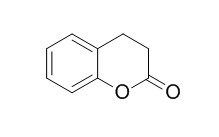3,4-Dihydrocoumarin
3,4-Dihydrocoumarin is widespread used as a flavoring agent in beverages, gelatins, puddings, candy, and other food items; as a fragrance in perfumes, creams, and cosmetics.
Inquire / Order:
manager@chemfaces.com
Technical Inquiries:
service@chemfaces.com
Tel:
+86-27-84237783
Fax:
+86-27-84254680
Address:
1 Building, No. 83, CheCheng Rd., Wuhan Economic and Technological Development Zone, Wuhan, Hubei 430056, PRC
Providing storage is as stated on the product vial and the vial is kept tightly sealed, the product can be stored for up to
24 months(2-8C).
Wherever possible, you should prepare and use solutions on the same day. However, if you need to make up stock solutions in advance, we recommend that you store the solution as aliquots in tightly sealed vials at -20C. Generally, these will be useable for up to two weeks. Before use, and prior to opening the vial we recommend that you allow your product to equilibrate to room temperature for at least 1 hour.
Need more advice on solubility, usage and handling? Please email to: service@chemfaces.com
The packaging of the product may have turned upside down during transportation, resulting in the natural compounds adhering to the neck or cap of the vial. take the vial out of its packaging and gently shake to let the compounds fall to the bottom of the vial. for liquid products, centrifuge at 200-500 RPM to gather the liquid at the bottom of the vial. try to avoid loss or contamination during handling.
Korean. J. Pestic. Sci.2024, 28(3):241-248.
Chem Biodivers.2023, 20(10):e202300741.
Geroscience.2024, 01207-y.
Microchemical Journal2024: 196:109676.
Pharmaceutics.2023, 15(6):1771.
BMC Complement Altern Med.2019, 19(1):367
Cell Death Dis.2019, 10(12):882
Korean Journal of Plant Resources2021, 34(1):52-58.
Molecules.2019, 24(24),4583
Front Immunol.2018, 9:2655
Related and Featured Products
Herba Polonica, 2010 , 56 (4) :14-9.
The influence of shading on the yield and quality of southern sweet-grass (Hierochloë australis (Schrad.) Roem. & Schult.) raw material[Reference:
WebLink]
Southern sweet-grass (Poaceae) rarely occurs in Polish coniferous or mixed forests. Leaves of this plant, rich in coumarin compounds, are mainly used as a flavouring raw material in alcohol, tobacco and cosmetic industry.
METHODS AND RESULTS:
The aim of the study was to investigate the influence of shading on the yield and quality of southern sweet-grass. The experiment was established at the certificated organic field of Department of Vegetable and Medicinal Plants. The sunlight was reduced up to 50 and 70% by using shading nets. The object of experiment was two-year-old plants grown on the alluvial soil. Leaves were harvested two times: in mid-May and in the last week of August (regrowth). The highest yield of leaves was observed at 50% of shading.
CONCLUSIONS:
The shaded plants were characterized by higher content of coumarin and 3,4-Dihydrocoumarin and lower content of bergapten in comparison to non-shaded ones. In the leaves five phenolic acids and two flavonoids were identified.
Natl Toxicol Program Tech Rep Ser. 1993 Sep;423:1-336.
NTP Toxicology and Carcinogenesis Studies of 3,4-Dihydrocoumarin (CAS No. 119-84-6) in F344/N Rats and B6C3F1 Mice (Gavage Studies).[Pubmed:
12616288]
3,4-Dihydrocoumarin was nominated by the Food and Drug Administration and the National Cancer Institute for study because of its widespread use as a flavoring agent in beverages, gelatins, puddings, candy, and other food items; as a fragrance in perfumes, creams, and cosmetics; and because of interest in the structure-activity relationships of the coumarin derivatives.
METHODS AND RESULTS:
Toxicity and carcinogenicity studies were conducted by administering 3,4-Dihydrocoumarin (99% pure) in corn oil by gavage to groups of male and female F344/N rats and B6C3F1 mice for 16 days, 13 weeks, and 2 years. Genetic toxicology studies were conducted in Salmonella typhimurium, cultured Chinese hamster ovary cells, and peripheral blood cells of mice.



